Unit 5 Management Accounting Report: ABC Co. Ltd Analysis
VerifiedAdded on 2023/01/10
|8
|1855
|33
Report
AI Summary
This report provides a detailed analysis of management accounting principles applied to ABC Co. Ltd., a manufacturer of electronic products. It begins by defining management accounting, its types, and the role of management accountants, contrasting it with financial accounting. The report then classifies costs to aid in managerial decision-making, differentiating between fixed, variable, and overhead costs. A significant portion is dedicated to calculating unit costs using absorption and marginal costing methods for two products, PC and VP. The report further explores the job order costing method for special orders, including relevant financial and non-financial considerations. The optimum production mix to maximize profit is determined, along with break-even analysis for a new product, IP. Finally, the report evaluates a proposal to spend $600,000 on promoting IP, assessing the impact on profitability and offering recommendations based on the analysis. The report is supported by references to academic literature.
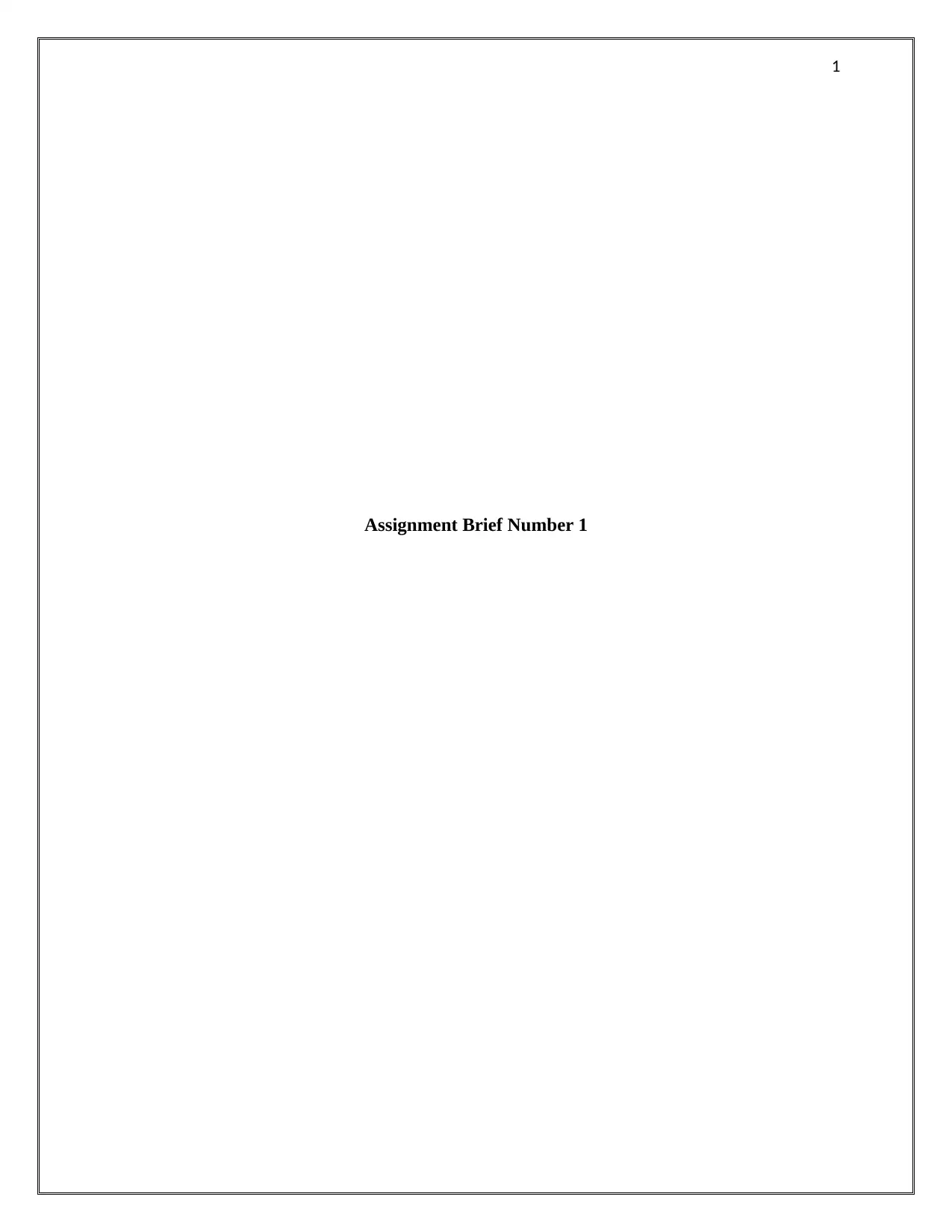
1
Assignment Brief Number 1
Assignment Brief Number 1
Secure Best Marks with AI Grader
Need help grading? Try our AI Grader for instant feedback on your assignments.
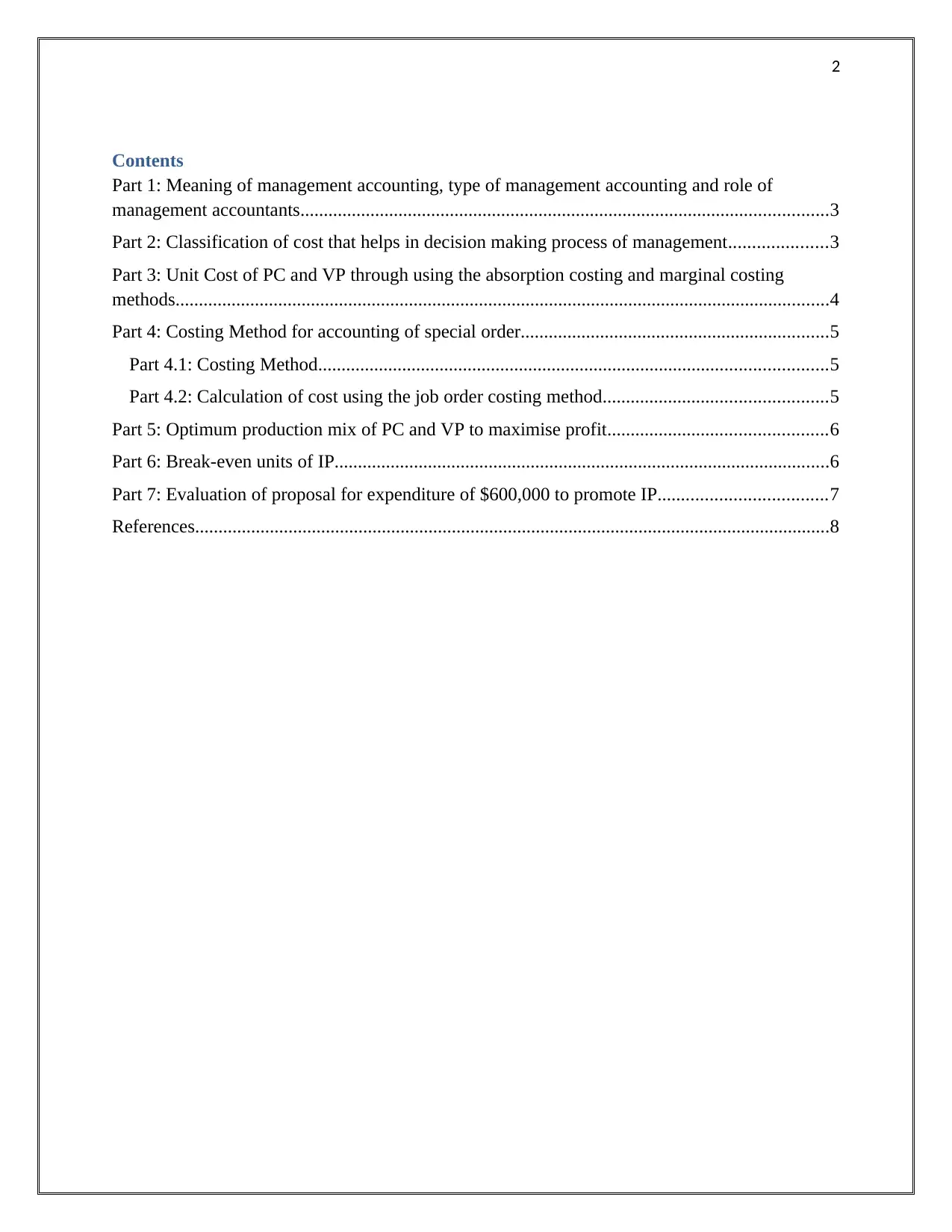
2
Contents
Part 1: Meaning of management accounting, type of management accounting and role of
management accountants.................................................................................................................3
Part 2: Classification of cost that helps in decision making process of management.....................3
Part 3: Unit Cost of PC and VP through using the absorption costing and marginal costing
methods............................................................................................................................................4
Part 4: Costing Method for accounting of special order..................................................................5
Part 4.1: Costing Method.............................................................................................................5
Part 4.2: Calculation of cost using the job order costing method................................................5
Part 5: Optimum production mix of PC and VP to maximise profit...............................................6
Part 6: Break-even units of IP..........................................................................................................6
Part 7: Evaluation of proposal for expenditure of $600,000 to promote IP....................................7
References........................................................................................................................................8
Contents
Part 1: Meaning of management accounting, type of management accounting and role of
management accountants.................................................................................................................3
Part 2: Classification of cost that helps in decision making process of management.....................3
Part 3: Unit Cost of PC and VP through using the absorption costing and marginal costing
methods............................................................................................................................................4
Part 4: Costing Method for accounting of special order..................................................................5
Part 4.1: Costing Method.............................................................................................................5
Part 4.2: Calculation of cost using the job order costing method................................................5
Part 5: Optimum production mix of PC and VP to maximise profit...............................................6
Part 6: Break-even units of IP..........................................................................................................6
Part 7: Evaluation of proposal for expenditure of $600,000 to promote IP....................................7
References........................................................................................................................................8
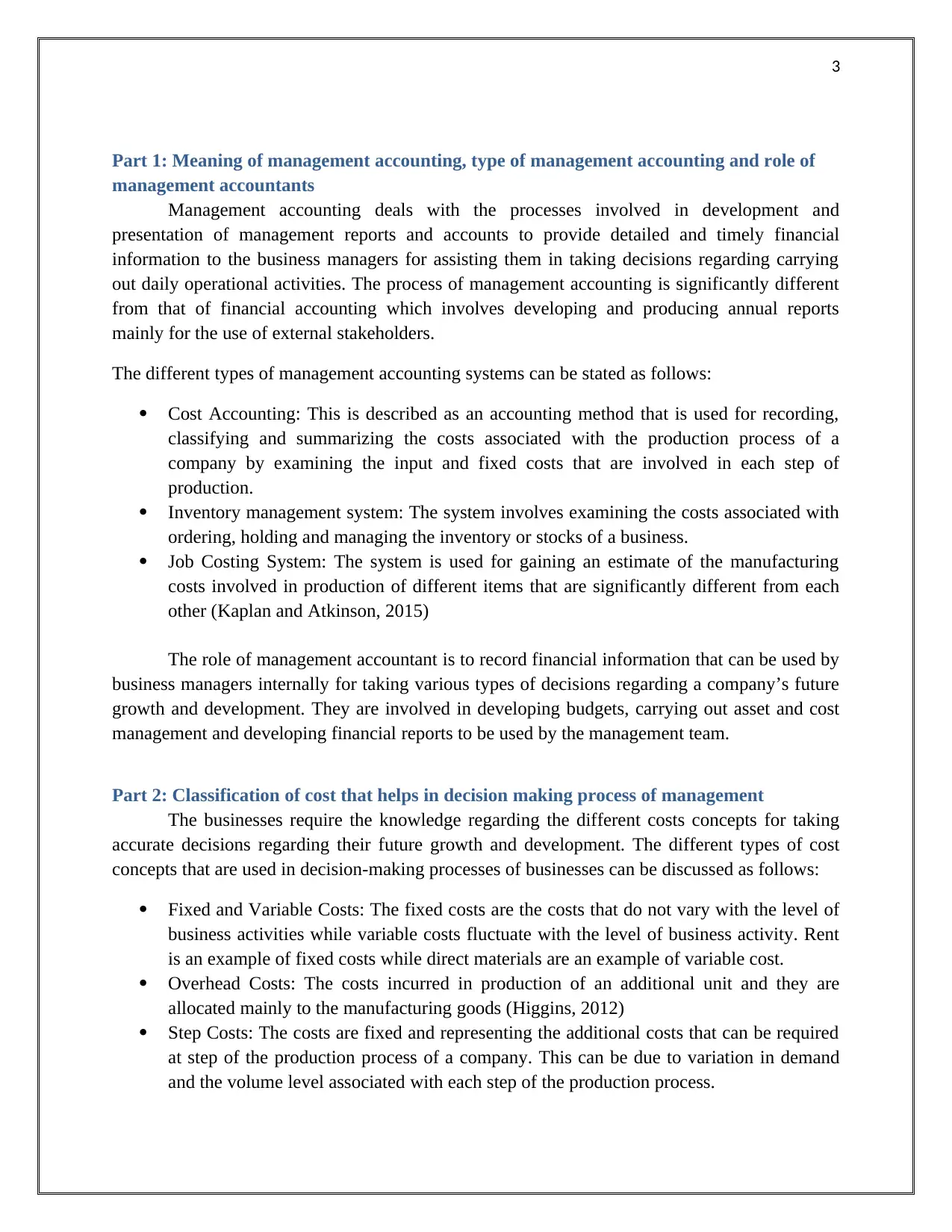
3
Part 1: Meaning of management accounting, type of management accounting and role of
management accountants
Management accounting deals with the processes involved in development and
presentation of management reports and accounts to provide detailed and timely financial
information to the business managers for assisting them in taking decisions regarding carrying
out daily operational activities. The process of management accounting is significantly different
from that of financial accounting which involves developing and producing annual reports
mainly for the use of external stakeholders.
The different types of management accounting systems can be stated as follows:
Cost Accounting: This is described as an accounting method that is used for recording,
classifying and summarizing the costs associated with the production process of a
company by examining the input and fixed costs that are involved in each step of
production.
Inventory management system: The system involves examining the costs associated with
ordering, holding and managing the inventory or stocks of a business.
Job Costing System: The system is used for gaining an estimate of the manufacturing
costs involved in production of different items that are significantly different from each
other (Kaplan and Atkinson, 2015)
The role of management accountant is to record financial information that can be used by
business managers internally for taking various types of decisions regarding a company’s future
growth and development. They are involved in developing budgets, carrying out asset and cost
management and developing financial reports to be used by the management team.
Part 2: Classification of cost that helps in decision making process of management
The businesses require the knowledge regarding the different costs concepts for taking
accurate decisions regarding their future growth and development. The different types of cost
concepts that are used in decision-making processes of businesses can be discussed as follows:
Fixed and Variable Costs: The fixed costs are the costs that do not vary with the level of
business activities while variable costs fluctuate with the level of business activity. Rent
is an example of fixed costs while direct materials are an example of variable cost.
Overhead Costs: The costs incurred in production of an additional unit and they are
allocated mainly to the manufacturing goods (Higgins, 2012)
Step Costs: The costs are fixed and representing the additional costs that can be required
at step of the production process of a company. This can be due to variation in demand
and the volume level associated with each step of the production process.
Part 1: Meaning of management accounting, type of management accounting and role of
management accountants
Management accounting deals with the processes involved in development and
presentation of management reports and accounts to provide detailed and timely financial
information to the business managers for assisting them in taking decisions regarding carrying
out daily operational activities. The process of management accounting is significantly different
from that of financial accounting which involves developing and producing annual reports
mainly for the use of external stakeholders.
The different types of management accounting systems can be stated as follows:
Cost Accounting: This is described as an accounting method that is used for recording,
classifying and summarizing the costs associated with the production process of a
company by examining the input and fixed costs that are involved in each step of
production.
Inventory management system: The system involves examining the costs associated with
ordering, holding and managing the inventory or stocks of a business.
Job Costing System: The system is used for gaining an estimate of the manufacturing
costs involved in production of different items that are significantly different from each
other (Kaplan and Atkinson, 2015)
The role of management accountant is to record financial information that can be used by
business managers internally for taking various types of decisions regarding a company’s future
growth and development. They are involved in developing budgets, carrying out asset and cost
management and developing financial reports to be used by the management team.
Part 2: Classification of cost that helps in decision making process of management
The businesses require the knowledge regarding the different costs concepts for taking
accurate decisions regarding their future growth and development. The different types of cost
concepts that are used in decision-making processes of businesses can be discussed as follows:
Fixed and Variable Costs: The fixed costs are the costs that do not vary with the level of
business activities while variable costs fluctuate with the level of business activity. Rent
is an example of fixed costs while direct materials are an example of variable cost.
Overhead Costs: The costs incurred in production of an additional unit and they are
allocated mainly to the manufacturing goods (Higgins, 2012)
Step Costs: The costs are fixed and representing the additional costs that can be required
at step of the production process of a company. This can be due to variation in demand
and the volume level associated with each step of the production process.
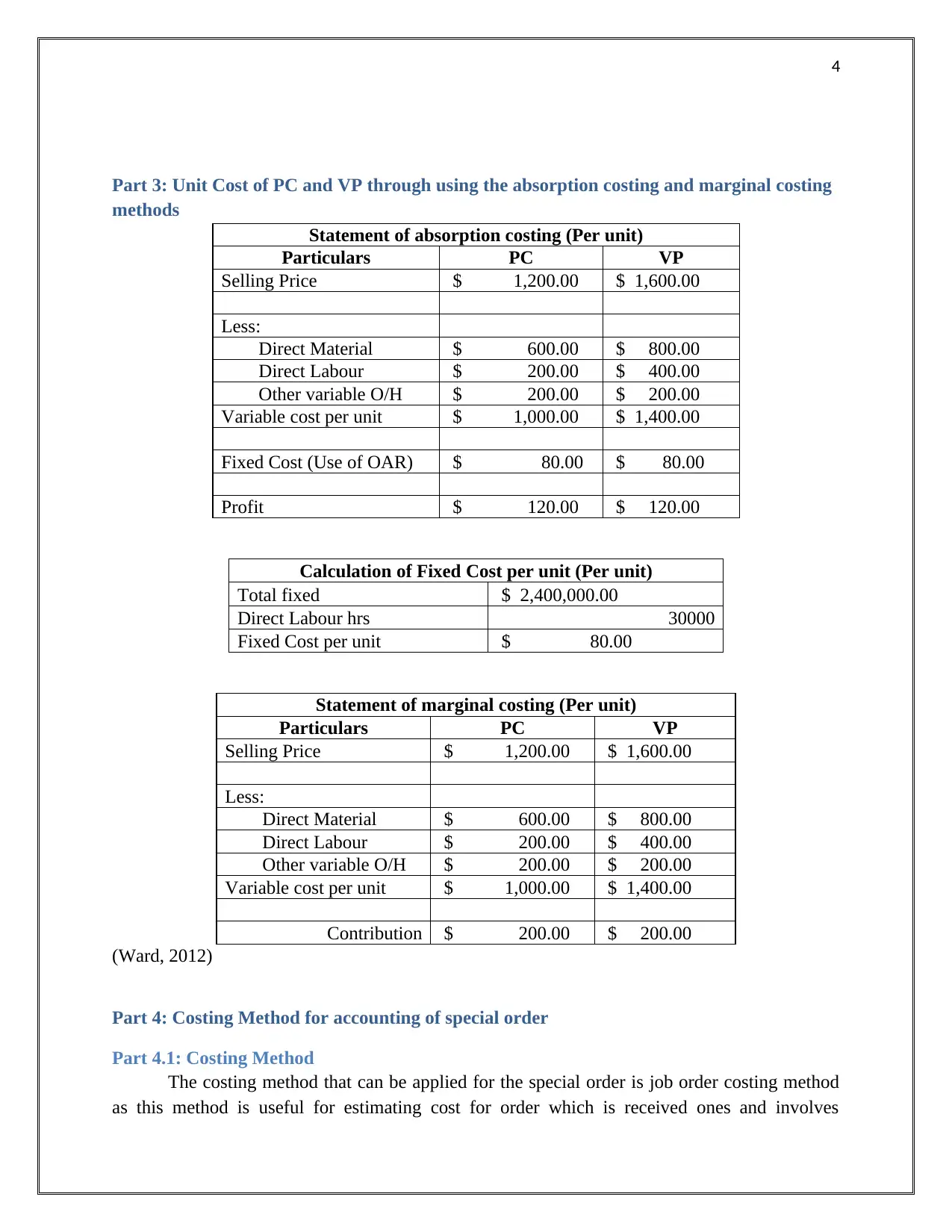
4
Part 3: Unit Cost of PC and VP through using the absorption costing and marginal costing
methods
Statement of absorption costing (Per unit)
Particulars PC VP
Selling Price $ 1,200.00 $ 1,600.00
Less:
Direct Material $ 600.00 $ 800.00
Direct Labour $ 200.00 $ 400.00
Other variable O/H $ 200.00 $ 200.00
Variable cost per unit $ 1,000.00 $ 1,400.00
Fixed Cost (Use of OAR) $ 80.00 $ 80.00
Profit $ 120.00 $ 120.00
Calculation of Fixed Cost per unit (Per unit)
Total fixed $ 2,400,000.00
Direct Labour hrs 30000
Fixed Cost per unit $ 80.00
Statement of marginal costing (Per unit)
Particulars PC VP
Selling Price $ 1,200.00 $ 1,600.00
Less:
Direct Material $ 600.00 $ 800.00
Direct Labour $ 200.00 $ 400.00
Other variable O/H $ 200.00 $ 200.00
Variable cost per unit $ 1,000.00 $ 1,400.00
Contribution $ 200.00 $ 200.00
(Ward, 2012)
Part 4: Costing Method for accounting of special order
Part 4.1: Costing Method
The costing method that can be applied for the special order is job order costing method
as this method is useful for estimating cost for order which is received ones and involves
Part 3: Unit Cost of PC and VP through using the absorption costing and marginal costing
methods
Statement of absorption costing (Per unit)
Particulars PC VP
Selling Price $ 1,200.00 $ 1,600.00
Less:
Direct Material $ 600.00 $ 800.00
Direct Labour $ 200.00 $ 400.00
Other variable O/H $ 200.00 $ 200.00
Variable cost per unit $ 1,000.00 $ 1,400.00
Fixed Cost (Use of OAR) $ 80.00 $ 80.00
Profit $ 120.00 $ 120.00
Calculation of Fixed Cost per unit (Per unit)
Total fixed $ 2,400,000.00
Direct Labour hrs 30000
Fixed Cost per unit $ 80.00
Statement of marginal costing (Per unit)
Particulars PC VP
Selling Price $ 1,200.00 $ 1,600.00
Less:
Direct Material $ 600.00 $ 800.00
Direct Labour $ 200.00 $ 400.00
Other variable O/H $ 200.00 $ 200.00
Variable cost per unit $ 1,000.00 $ 1,400.00
Contribution $ 200.00 $ 200.00
(Ward, 2012)
Part 4: Costing Method for accounting of special order
Part 4.1: Costing Method
The costing method that can be applied for the special order is job order costing method
as this method is useful for estimating cost for order which is received ones and involves
Secure Best Marks with AI Grader
Need help grading? Try our AI Grader for instant feedback on your assignments.
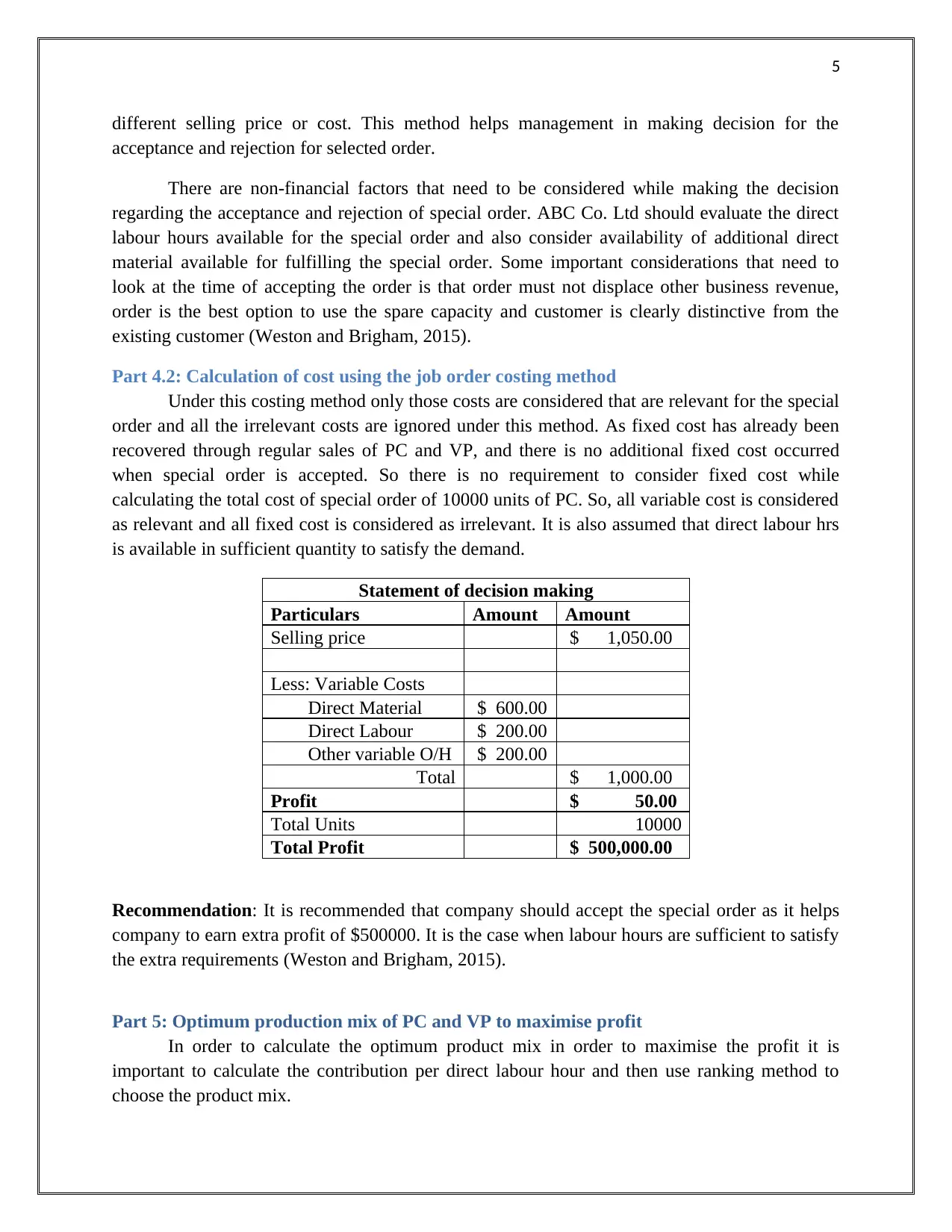
5
different selling price or cost. This method helps management in making decision for the
acceptance and rejection for selected order.
There are non-financial factors that need to be considered while making the decision
regarding the acceptance and rejection of special order. ABC Co. Ltd should evaluate the direct
labour hours available for the special order and also consider availability of additional direct
material available for fulfilling the special order. Some important considerations that need to
look at the time of accepting the order is that order must not displace other business revenue,
order is the best option to use the spare capacity and customer is clearly distinctive from the
existing customer (Weston and Brigham, 2015).
Part 4.2: Calculation of cost using the job order costing method
Under this costing method only those costs are considered that are relevant for the special
order and all the irrelevant costs are ignored under this method. As fixed cost has already been
recovered through regular sales of PC and VP, and there is no additional fixed cost occurred
when special order is accepted. So there is no requirement to consider fixed cost while
calculating the total cost of special order of 10000 units of PC. So, all variable cost is considered
as relevant and all fixed cost is considered as irrelevant. It is also assumed that direct labour hrs
is available in sufficient quantity to satisfy the demand.
Statement of decision making
Particulars Amount Amount
Selling price $ 1,050.00
Less: Variable Costs
Direct Material $ 600.00
Direct Labour $ 200.00
Other variable O/H $ 200.00
Total $ 1,000.00
Profit $ 50.00
Total Units 10000
Total Profit $ 500,000.00
Recommendation: It is recommended that company should accept the special order as it helps
company to earn extra profit of $500000. It is the case when labour hours are sufficient to satisfy
the extra requirements (Weston and Brigham, 2015).
Part 5: Optimum production mix of PC and VP to maximise profit
In order to calculate the optimum product mix in order to maximise the profit it is
important to calculate the contribution per direct labour hour and then use ranking method to
choose the product mix.
different selling price or cost. This method helps management in making decision for the
acceptance and rejection for selected order.
There are non-financial factors that need to be considered while making the decision
regarding the acceptance and rejection of special order. ABC Co. Ltd should evaluate the direct
labour hours available for the special order and also consider availability of additional direct
material available for fulfilling the special order. Some important considerations that need to
look at the time of accepting the order is that order must not displace other business revenue,
order is the best option to use the spare capacity and customer is clearly distinctive from the
existing customer (Weston and Brigham, 2015).
Part 4.2: Calculation of cost using the job order costing method
Under this costing method only those costs are considered that are relevant for the special
order and all the irrelevant costs are ignored under this method. As fixed cost has already been
recovered through regular sales of PC and VP, and there is no additional fixed cost occurred
when special order is accepted. So there is no requirement to consider fixed cost while
calculating the total cost of special order of 10000 units of PC. So, all variable cost is considered
as relevant and all fixed cost is considered as irrelevant. It is also assumed that direct labour hrs
is available in sufficient quantity to satisfy the demand.
Statement of decision making
Particulars Amount Amount
Selling price $ 1,050.00
Less: Variable Costs
Direct Material $ 600.00
Direct Labour $ 200.00
Other variable O/H $ 200.00
Total $ 1,000.00
Profit $ 50.00
Total Units 10000
Total Profit $ 500,000.00
Recommendation: It is recommended that company should accept the special order as it helps
company to earn extra profit of $500000. It is the case when labour hours are sufficient to satisfy
the extra requirements (Weston and Brigham, 2015).
Part 5: Optimum production mix of PC and VP to maximise profit
In order to calculate the optimum product mix in order to maximise the profit it is
important to calculate the contribution per direct labour hour and then use ranking method to
choose the product mix.
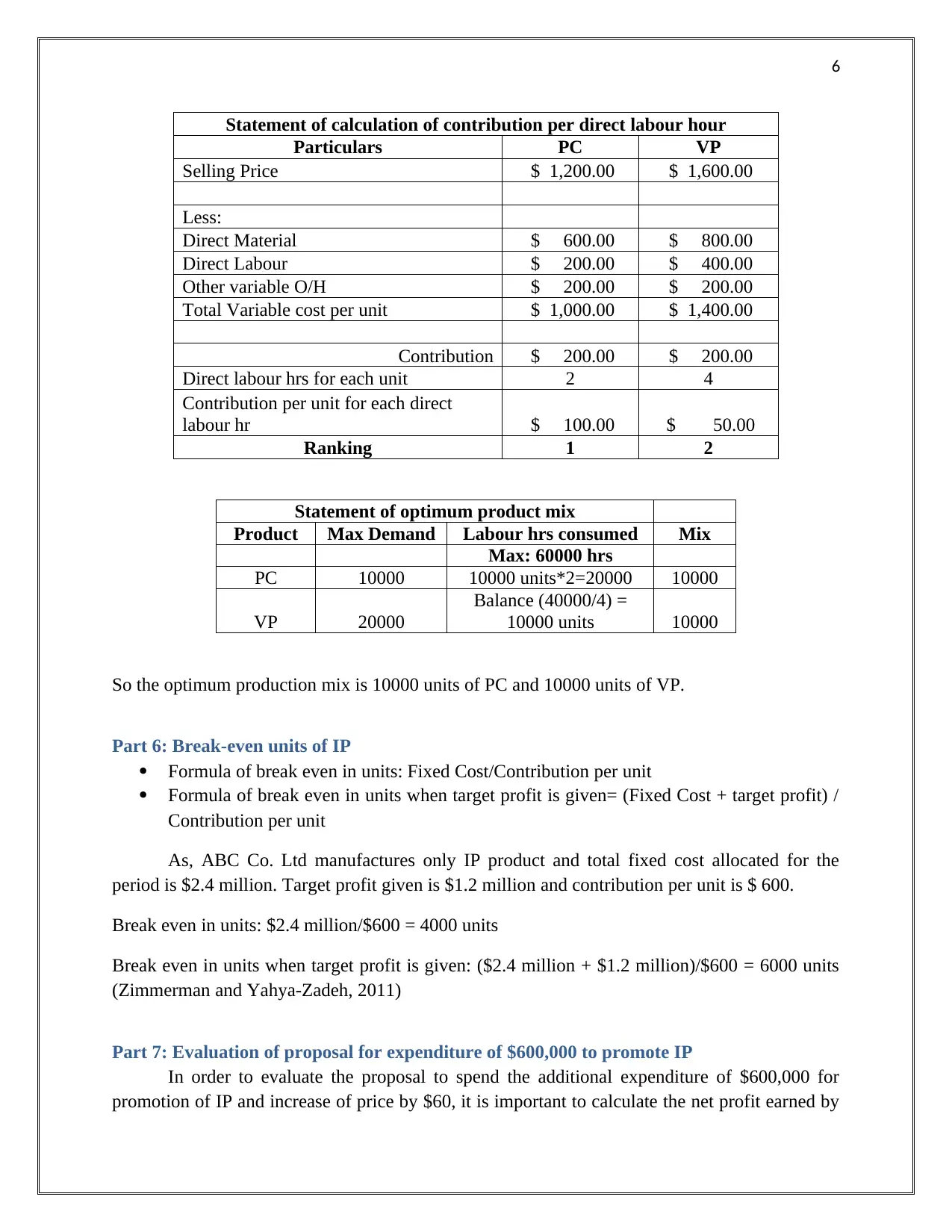
6
Statement of calculation of contribution per direct labour hour
Particulars PC VP
Selling Price $ 1,200.00 $ 1,600.00
Less:
Direct Material $ 600.00 $ 800.00
Direct Labour $ 200.00 $ 400.00
Other variable O/H $ 200.00 $ 200.00
Total Variable cost per unit $ 1,000.00 $ 1,400.00
Contribution $ 200.00 $ 200.00
Direct labour hrs for each unit 2 4
Contribution per unit for each direct
labour hr $ 100.00 $ 50.00
Ranking 1 2
Statement of optimum product mix
Product Max Demand Labour hrs consumed Mix
Max: 60000 hrs
PC 10000 10000 units*2=20000 10000
VP 20000
Balance (40000/4) =
10000 units 10000
So the optimum production mix is 10000 units of PC and 10000 units of VP.
Part 6: Break-even units of IP
Formula of break even in units: Fixed Cost/Contribution per unit
Formula of break even in units when target profit is given= (Fixed Cost + target profit) /
Contribution per unit
As, ABC Co. Ltd manufactures only IP product and total fixed cost allocated for the
period is $2.4 million. Target profit given is $1.2 million and contribution per unit is $ 600.
Break even in units: $2.4 million/$600 = 4000 units
Break even in units when target profit is given: ($2.4 million + $1.2 million)/$600 = 6000 units
(Zimmerman and Yahya-Zadeh, 2011)
Part 7: Evaluation of proposal for expenditure of $600,000 to promote IP
In order to evaluate the proposal to spend the additional expenditure of $600,000 for
promotion of IP and increase of price by $60, it is important to calculate the net profit earned by
Statement of calculation of contribution per direct labour hour
Particulars PC VP
Selling Price $ 1,200.00 $ 1,600.00
Less:
Direct Material $ 600.00 $ 800.00
Direct Labour $ 200.00 $ 400.00
Other variable O/H $ 200.00 $ 200.00
Total Variable cost per unit $ 1,000.00 $ 1,400.00
Contribution $ 200.00 $ 200.00
Direct labour hrs for each unit 2 4
Contribution per unit for each direct
labour hr $ 100.00 $ 50.00
Ranking 1 2
Statement of optimum product mix
Product Max Demand Labour hrs consumed Mix
Max: 60000 hrs
PC 10000 10000 units*2=20000 10000
VP 20000
Balance (40000/4) =
10000 units 10000
So the optimum production mix is 10000 units of PC and 10000 units of VP.
Part 6: Break-even units of IP
Formula of break even in units: Fixed Cost/Contribution per unit
Formula of break even in units when target profit is given= (Fixed Cost + target profit) /
Contribution per unit
As, ABC Co. Ltd manufactures only IP product and total fixed cost allocated for the
period is $2.4 million. Target profit given is $1.2 million and contribution per unit is $ 600.
Break even in units: $2.4 million/$600 = 4000 units
Break even in units when target profit is given: ($2.4 million + $1.2 million)/$600 = 6000 units
(Zimmerman and Yahya-Zadeh, 2011)
Part 7: Evaluation of proposal for expenditure of $600,000 to promote IP
In order to evaluate the proposal to spend the additional expenditure of $600,000 for
promotion of IP and increase of price by $60, it is important to calculate the net profit earned by
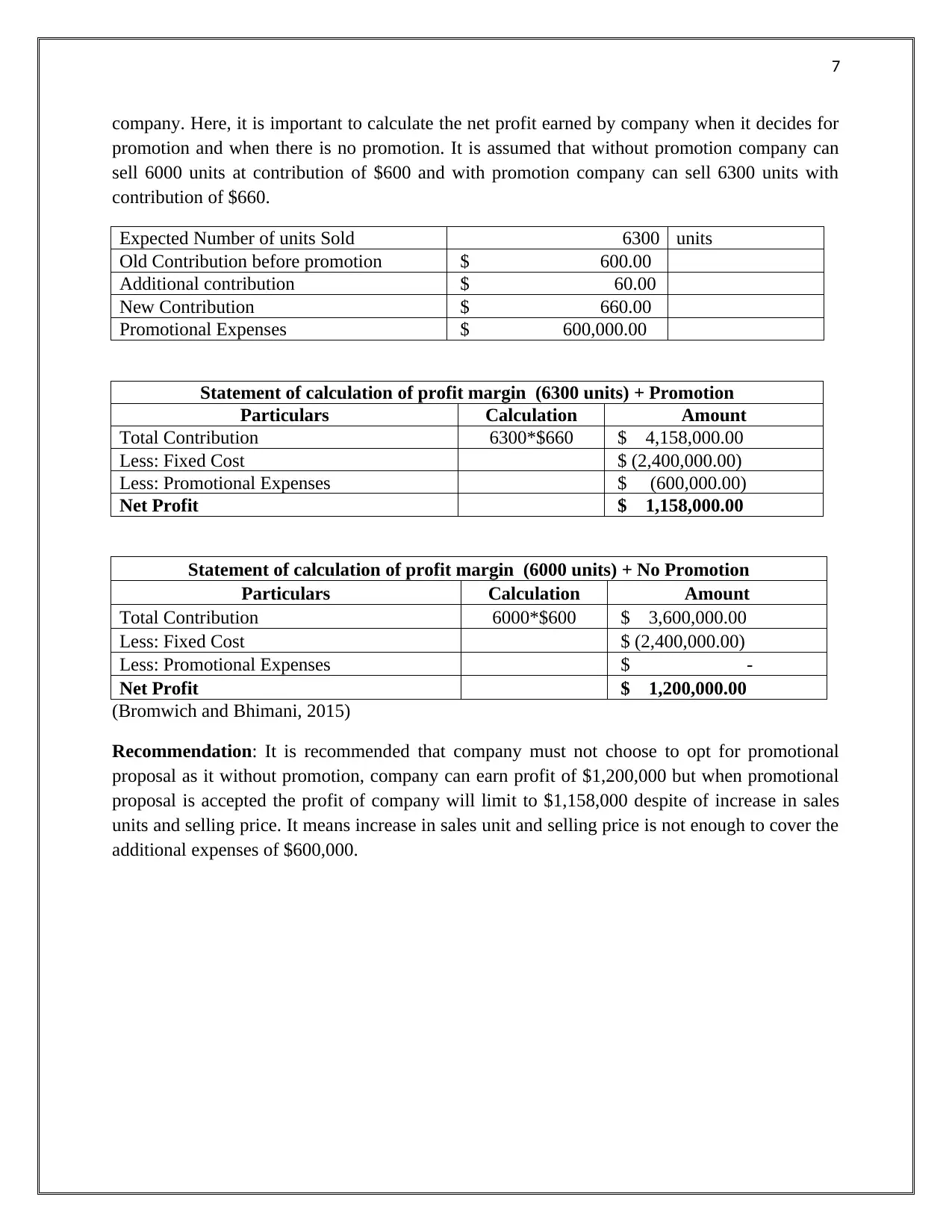
7
company. Here, it is important to calculate the net profit earned by company when it decides for
promotion and when there is no promotion. It is assumed that without promotion company can
sell 6000 units at contribution of $600 and with promotion company can sell 6300 units with
contribution of $660.
Expected Number of units Sold 6300 units
Old Contribution before promotion $ 600.00
Additional contribution $ 60.00
New Contribution $ 660.00
Promotional Expenses $ 600,000.00
Statement of calculation of profit margin (6300 units) + Promotion
Particulars Calculation Amount
Total Contribution 6300*$660 $ 4,158,000.00
Less: Fixed Cost $ (2,400,000.00)
Less: Promotional Expenses $ (600,000.00)
Net Profit $ 1,158,000.00
Statement of calculation of profit margin (6000 units) + No Promotion
Particulars Calculation Amount
Total Contribution 6000*$600 $ 3,600,000.00
Less: Fixed Cost $ (2,400,000.00)
Less: Promotional Expenses $ -
Net Profit $ 1,200,000.00
(Bromwich and Bhimani, 2015)
Recommendation: It is recommended that company must not choose to opt for promotional
proposal as it without promotion, company can earn profit of $1,200,000 but when promotional
proposal is accepted the profit of company will limit to $1,158,000 despite of increase in sales
units and selling price. It means increase in sales unit and selling price is not enough to cover the
additional expenses of $600,000.
company. Here, it is important to calculate the net profit earned by company when it decides for
promotion and when there is no promotion. It is assumed that without promotion company can
sell 6000 units at contribution of $600 and with promotion company can sell 6300 units with
contribution of $660.
Expected Number of units Sold 6300 units
Old Contribution before promotion $ 600.00
Additional contribution $ 60.00
New Contribution $ 660.00
Promotional Expenses $ 600,000.00
Statement of calculation of profit margin (6300 units) + Promotion
Particulars Calculation Amount
Total Contribution 6300*$660 $ 4,158,000.00
Less: Fixed Cost $ (2,400,000.00)
Less: Promotional Expenses $ (600,000.00)
Net Profit $ 1,158,000.00
Statement of calculation of profit margin (6000 units) + No Promotion
Particulars Calculation Amount
Total Contribution 6000*$600 $ 3,600,000.00
Less: Fixed Cost $ (2,400,000.00)
Less: Promotional Expenses $ -
Net Profit $ 1,200,000.00
(Bromwich and Bhimani, 2015)
Recommendation: It is recommended that company must not choose to opt for promotional
proposal as it without promotion, company can earn profit of $1,200,000 but when promotional
proposal is accepted the profit of company will limit to $1,158,000 despite of increase in sales
units and selling price. It means increase in sales unit and selling price is not enough to cover the
additional expenses of $600,000.
Paraphrase This Document
Need a fresh take? Get an instant paraphrase of this document with our AI Paraphraser
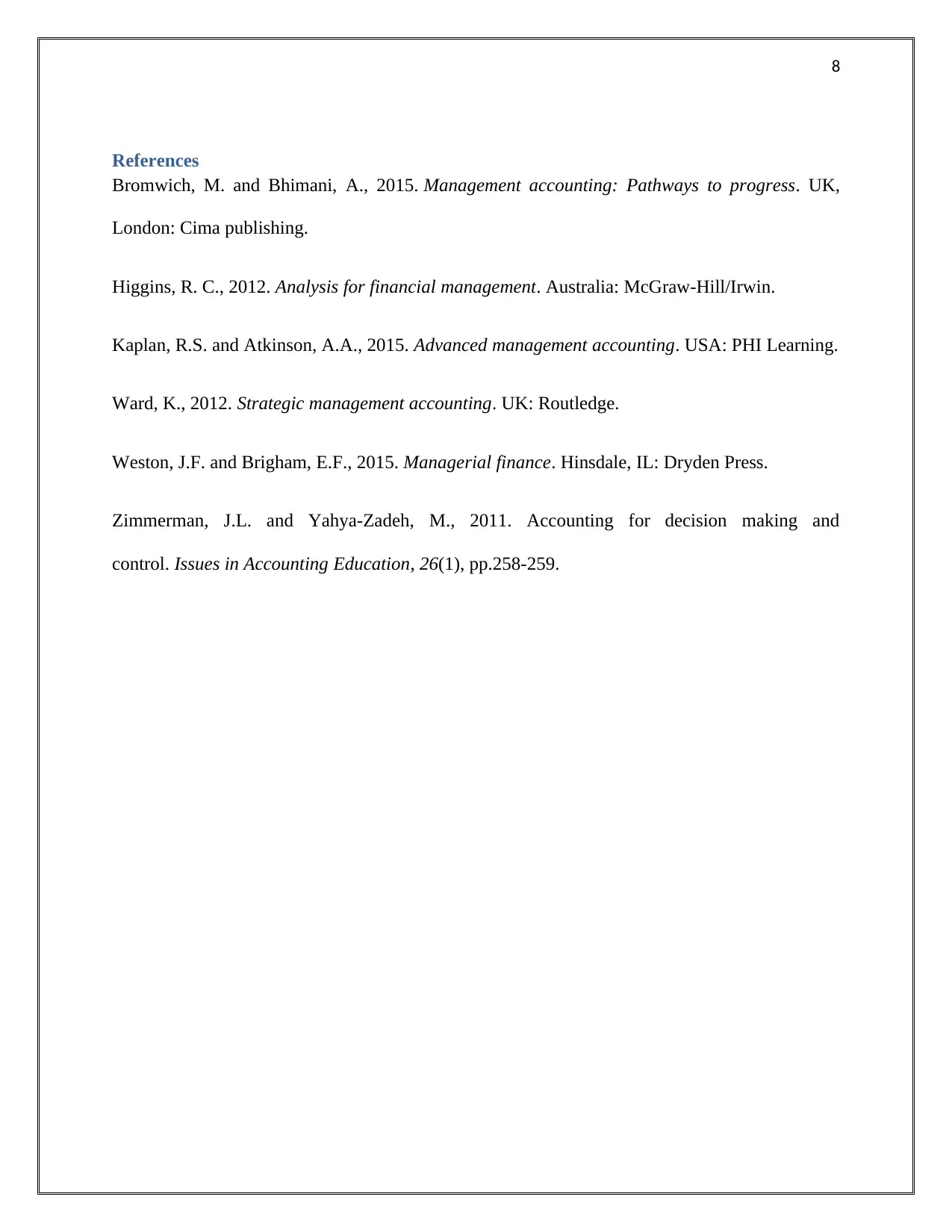
8
References
Bromwich, M. and Bhimani, A., 2015. Management accounting: Pathways to progress. UK,
London: Cima publishing.
Higgins, R. C., 2012. Analysis for financial management. Australia: McGraw-Hill/Irwin.
Kaplan, R.S. and Atkinson, A.A., 2015. Advanced management accounting. USA: PHI Learning.
Ward, K., 2012. Strategic management accounting. UK: Routledge.
Weston, J.F. and Brigham, E.F., 2015. Managerial finance. Hinsdale, IL: Dryden Press.
Zimmerman, J.L. and Yahya-Zadeh, M., 2011. Accounting for decision making and
control. Issues in Accounting Education, 26(1), pp.258-259.
References
Bromwich, M. and Bhimani, A., 2015. Management accounting: Pathways to progress. UK,
London: Cima publishing.
Higgins, R. C., 2012. Analysis for financial management. Australia: McGraw-Hill/Irwin.
Kaplan, R.S. and Atkinson, A.A., 2015. Advanced management accounting. USA: PHI Learning.
Ward, K., 2012. Strategic management accounting. UK: Routledge.
Weston, J.F. and Brigham, E.F., 2015. Managerial finance. Hinsdale, IL: Dryden Press.
Zimmerman, J.L. and Yahya-Zadeh, M., 2011. Accounting for decision making and
control. Issues in Accounting Education, 26(1), pp.258-259.
1 out of 8
Related Documents
Your All-in-One AI-Powered Toolkit for Academic Success.
+13062052269
info@desklib.com
Available 24*7 on WhatsApp / Email
![[object Object]](/_next/static/media/star-bottom.7253800d.svg)
Unlock your academic potential
© 2024 | Zucol Services PVT LTD | All rights reserved.




